A hard-fought championship: Championnat de France 1947
Part 2: The Races
Author
- Alessandro Silva
Date
- January 16, 2004; a pre-publication of the book BACK ON TRACK, Sept 9th, 1945 to May 13th, 1950 (compiled from chapters 8, 9 and 12) by the author
Related articles
- Back on Track, racing in the 40s: Sept 9th, 1945 to May 13th, 1950, by Alessandro Silva
- First outtake: The right place to start: cosmopolitan Riviera, France (revised chapter 1)
- Second outtake: A hard fought championship: Championnat de France, 1947 (compiled from chapters 8, 9 and 12)
- Part 1: Cars and Drivers
- Part 3: The Statistics
- 1946 GP des Nations - How the great Tazio came to ignore a black flag... and get away with it, by Leif Snellman/Mattijs Diepraam/Felix Muelas/'Uechtel'
- 1947 Italian Championship - The race when Nuvolari waved the steering wheel at the crowd and a forgotten Championship, by Alessandro Silva
- Alberto Ascari - Cursed natural talent, by Mattijs Diepraam/Felix Muelas/Leif Snellman
- Delage - A World Champion manufacturer, by Leif Snellman/Josh Lintz
- Delahaye - René Dreyfus and the upset at Pau, by Leif Snellman
- Philippe Étancelin - Phi-Phi's hat trick, by Leif Snellman
- Gordini - Nimble, elegant, ultimately French, by Mattijs Diepraam/Felix Muelas
- Tazio Nuvolari - Mantua's Great Little Man, by Leif Snellman
- Raymond Sommer - The heart of a lion, by Felix Muelas/Michael Müller
- Luigi Villoresi - Ascari's mentor, by Leif Snellman/Robert Blinkhorn
- Jean-Pierre Wimille - The uncrowned king of the forties, by Mattijs Diepraam
Who?Charles Pozzi What?Talbot-Lago Spéciale 90203 Where?Montlhéry When?III Grand Prix du Salon (November 11, 1947) |
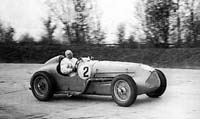 |
Why?
Click here to go back to part 1: Cars and Drivers
After having been put in the calendar but not raced in the summer of 1946, the Grand Prix de Pau returned on Easter Monday in 1947.
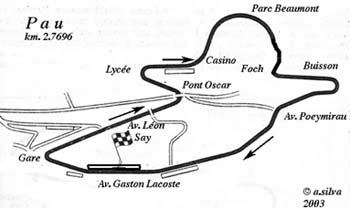 Motor racing at Pau had started as early as 1899 and continues to date. This revival continued the sequence of races held between 1933 and 1939 (with a 1-year interruption in 1934). The choice of a new “circuit dans la cité“ instead of the road circuit located in the outskirts of town used for the 1930 Grand Prix de l’ACF has proved to be a winning one. Pau had witnessed the stunning victory of Dreyfus’ Delahaye over the Mercedes-Benz team in 1938 and Lang’s revenge a year later at a record average speed of 88.666 kph. a figure that gives evidence of the severity of the twisty and short track.
Motor racing at Pau had started as early as 1899 and continues to date. This revival continued the sequence of races held between 1933 and 1939 (with a 1-year interruption in 1934). The choice of a new “circuit dans la cité“ instead of the road circuit located in the outskirts of town used for the 1930 Grand Prix de l’ACF has proved to be a winning one. Pau had witnessed the stunning victory of Dreyfus’ Delahaye over the Mercedes-Benz team in 1938 and Lang’s revenge a year later at a record average speed of 88.666 kph. a figure that gives evidence of the severity of the twisty and short track.
In presenting the race Charles Faroux could write that “un parcours de 305 kms éprouve les mechaniques d’une façon utile et féconde” ('A distance of 305 kms puts mechanical parts to a useful and fruitful test'): the Petits Grands Prix had reached back to pre-war standards as distances were concerned.
Fifteen cars showed up in Pau for the Easter weekend, accompanied by motorcycles for the first time. Raymond Sommer arrived with his personal blue Maserati 4CL enjoying Scuderia Milan pit assistance. The team fron Milan took alomg three cars for Nello Pagani, team owner Arialdo Ruggeri and Louveau. Their adversaries were the Ecurie France cars, the Talbot MC and the Delahayes, the Ecurie GERSAC Delages, in Pau for their maiden race, and Wimille’s Gordini, a debut awaited with trepidation both by the French public and the insiders. From England came “B Bira” with ERA 2B “Romulus” and Ian Connell with Kenneth Evans in the Maserati 6CM/4CL used by Sommer the previous year. We have just related the strange circumstances under which the British pair had had that car put at their disposal.
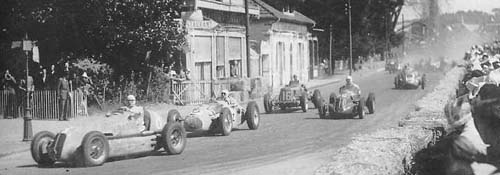
GP de Pau, the start. Sommer, Chaboud, Louveau, “B Bira”, “Levegh”
Only fourteen cars qualified. Rosier in his newly re-bodied Talbot Spéciale 90111 suffered clutch and brakes troubles due to the hasty preparation of the car and was the non-qualifier. Sommer easily took pole by a large margin over Chaboud’s Talbot MC. “Levegh” was the fastest among the new Ecurie GERSAC Delages, Trillaud among the Delahayes, seemingly slower than the Delages. Wimille’s Gordini was sixth, but eight seconds slower than Sommer. The Milan cars looked even more indifferent than usual, in contrast to ‘B Bira”, always magnificent at wringing out the best from his old car, who finished third and started in second row.
A common inconvenience of the Talbot Lago engines was backfire in the carburettors. It happened to Chaboud on race day during the wam-up laps right before the start. Regnier put the car back in starting condition with amazing speed, but the Talbot could start the race only because the forgiving organizers delayed the start by 15 minutes.
Sommer jumped out in front followed by Chaboud, ‘B Bira” and Louveau. The race of the Talbot MC did nost last long: by lap 5 the engine was ailing and by lap 8 it had retired with a burnt head-gasket. Meanwhile during the first lap Arialdo Ruggeri suffered a terrible crash at the Lycée turn. He hit first a lamppost and then a fence and was seriously injured with multiple fractures to his legs and a smashed in chest. Ruggeri declared that he had walked on an oil spill before the start. The sole of his right shoe slipped from the brake pedal and pushed the accelarator as a consequence. Ruggeri was out for the year. He recovered, but meanwhile his team, which had just lost backing from the Maserati firm, went deeper into financial troubles and organizational problems.
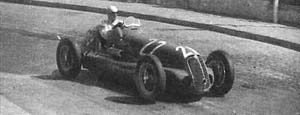 Meanwhile Pagani (pictured on the right), in just his third car race after Barcelona and Cairo, was coming from behind at high speed. Sixth on lap 1 he was third on lap five and second on lap 22, after overtaking “B Bira’. The Siamese driver’s famous ERA later exhaled its last breath in a spectacular fashion by throwing a connecting rod out of the cylinder block on the main straight. “B Bira”’s more successful car was never raced again by him. Wimille had followed Pagani at some 20” distance and found himself in third position. The nimble SIMCA-Gordini did not look totally at ease that day. Well-driven by Wimille on a suitable twisty course, it should have been closer to the leaders. Jean-Pierre felt the clutch slipping and stopped on lap 46. Gordini was having a typical fit of rage and seemingly he did not trust his driver. Wearing a motorcycle-style helmet, he jumped into the car and took off to check what was wrong. Evidence stopped him after few laps. Sommer was undisturbed in front even after the usual “opera comique”-type Milan pitwork, but he had to stop again to change the magneto losing five laps from Pagani. Going round the circuit faster and faster Sommer set fastest lap of the day on his 76th, but on lap 79th a tyre burst after hitting a curb. Sommer coolly decided to hit a tree to avoid going directly into a fence with spectators behind it. The car dealt the fence a glancing blow, mitigating the number of specator injuries: reports say only that there were several, with one boy reported to have suffered a fractured skull, but the toll could have been much higher. Sommer escaped unhurt. The last thirty laps were uneventful. Pagani’s advantage was so huge that even though his gearbox broke on the penultimate lap, he could cruise home safely winning by two laps from “Levegh”, “calm, energetic and consistent” whereas Pagani was “a wise and alert” driver. Louveau provided some excitement climbing from 8th to 3rd place in the second half of the race. Achard finished fourth but he “has to work on his curves”. (Click here for a lapchart of the race.) The first Championship table saw the following scores: “Levegh” 6, Louveau 5, Achard 4, Sommer 2, Etancelin & Grignard 1.5, Chaboud & Giraud-Cabantous 0.5.
Meanwhile Pagani (pictured on the right), in just his third car race after Barcelona and Cairo, was coming from behind at high speed. Sixth on lap 1 he was third on lap five and second on lap 22, after overtaking “B Bira’. The Siamese driver’s famous ERA later exhaled its last breath in a spectacular fashion by throwing a connecting rod out of the cylinder block on the main straight. “B Bira”’s more successful car was never raced again by him. Wimille had followed Pagani at some 20” distance and found himself in third position. The nimble SIMCA-Gordini did not look totally at ease that day. Well-driven by Wimille on a suitable twisty course, it should have been closer to the leaders. Jean-Pierre felt the clutch slipping and stopped on lap 46. Gordini was having a typical fit of rage and seemingly he did not trust his driver. Wearing a motorcycle-style helmet, he jumped into the car and took off to check what was wrong. Evidence stopped him after few laps. Sommer was undisturbed in front even after the usual “opera comique”-type Milan pitwork, but he had to stop again to change the magneto losing five laps from Pagani. Going round the circuit faster and faster Sommer set fastest lap of the day on his 76th, but on lap 79th a tyre burst after hitting a curb. Sommer coolly decided to hit a tree to avoid going directly into a fence with spectators behind it. The car dealt the fence a glancing blow, mitigating the number of specator injuries: reports say only that there were several, with one boy reported to have suffered a fractured skull, but the toll could have been much higher. Sommer escaped unhurt. The last thirty laps were uneventful. Pagani’s advantage was so huge that even though his gearbox broke on the penultimate lap, he could cruise home safely winning by two laps from “Levegh”, “calm, energetic and consistent” whereas Pagani was “a wise and alert” driver. Louveau provided some excitement climbing from 8th to 3rd place in the second half of the race. Achard finished fourth but he “has to work on his curves”. (Click here for a lapchart of the race.) The first Championship table saw the following scores: “Levegh” 6, Louveau 5, Achard 4, Sommer 2, Etancelin & Grignard 1.5, Chaboud & Giraud-Cabantous 0.5.
Inspection of lap times at Pau had shown a difference of only 10 seconds between the fastest, Sommer, and the slowest, Trillaud. Differences of galactic sizes in the performances of GP cars seen the year before were about to disappear. Pagani’s average speed for the race (83.650 kph) does not look too bad when compared with Lang’s 88.666 in 1939. Sommer’s fastest lap at 91.390 kph looks even better compared with Lang, von Brautschisch and Caracciola 93.182.
Sommer bats les records mais Chaboud gagne [Sommer beats all records but Chaboud wins]
The next French race – three weeks later – was the Grand Prix du Roussillon in Perpignan, which the organizers had brought forward to the spring after the terrible summer heat suffered in the preceding edition. The Perpignan race was not valid for the Championship, a fact heavily criticized by L’Equipe. “Si la logique etait respectée” (if logic had been respected) it should have been a Championship round. As a matter of fact there was actually some logic in the decision: the distance was one third of the other Championship races and only 12 cars were permitted on the narrow track. Furthermore, no foreign competitor showed up after Platé and Scuderia Milan had failed to come to an agreement about starting money.
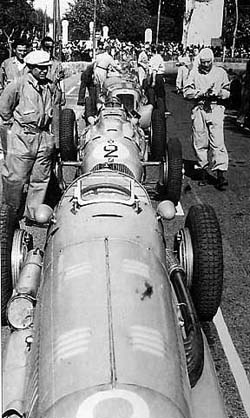
Starting line-up in Perpignan: Sommer, Chaboud, “Levegh”
Four GERSAC Delages were pitted against three Ecurie France Delahayes and the Talbot MC, with Grignard back in his 1946 Delahaye, already sold to Meyrat, and Rosier in the Talbot Spéciale. The favourites were of course the two best French drivers, Sommer in the hastily repaired Maserati and Wimille in the SIMCA-Gordini.
Sommmer was the fastest in practice from Wimille and Chaboud, whose Talbot MC had been shipped back to Paris after the race at Pau to get a complete overhaul. Yet, there were again backfires in the carburettors twice during practice. Chaboud set third time. Next to him was Giraud-Cabantous in the fastest Delahaye and behind him “Levegh”, fifth time in the fastest Delage.
The two stars took off like men possessed at the start. Sommer, who had been able to maintain first position, built up a very small advantage until about the 18th lap, when Wimille’s SIMCA-Gordini started to show high oil temperatures that obliged Wimille to stop on lap 21st. Gordini had exhausted his pre-war oil supply and was testing a new one that was not working well. Until then Chaboud had been content to keep third position in his bigger car, less suitable for the twisty track. After passing Wimille’s ailing car, Chaboud started the chase. On lap 20 he was 14th behind Sommer, 8th on lap 30 and 3rd on lap 40. Sommer’s car disintegrated by lap 44, with at least supercharger and gearbox out of commission.
 It was then easy for a Chaboud in great form to cruise home to win from Louveau’s new Delage, 880004 (seen in the picture on the right, about to be lapped by the winner), Giraud-Cabantous, who had won an important sports car race at San Remo two weeks before in the same car (Yves’ 59th victory!) and “Levegh”.
It was then easy for a Chaboud in great form to cruise home to win from Louveau’s new Delage, 880004 (seen in the picture on the right, about to be lapped by the winner), Giraud-Cabantous, who had won an important sports car race at San Remo two weeks before in the same car (Yves’ 59th victory!) and “Levegh”.
Fastest laps show a difference of about eleven seconds between fastest – Sommer as usual – and slowest times, Achard, a slightly bigger gap than in Pau.
Chaboud’s average speed had improved on Wimille’s 1946 one by going from 91.673 to 92.882 kph. Sommer’s fastest lap did too, from 95.174 to 97.088 kph.
Il n’etait evidemment pas favori, mais… [Clearly he was not the favourite, but…]
The next Championship round was the international race at Marseille. The race in 1946 had been a popular success, which pushed the Automobile Club de Marseille et Provence to renew their efforts for a new edition. The Prado track was revised, making it faster and longer. Along the beach, a stretch of equal length as the one in the NW direction was added in the SE direction. The tricky foray towards Parc Borely from Boulevard du Prado was removed. A clean T-shaped circuit was thus obtained, with three hairpins, two right-hand 90-degree turns with just one chicane between turns 1 and 2. The tramway tracks were filled by tarmac for the weekend, which was removed the night after the race! The Grand Prix also relinquished the previous format with heats and final, returning to a classic 3-hour long race. A motorcycle race was also held on Saturday afternoon between the rounds of practice for the Grand Prix.
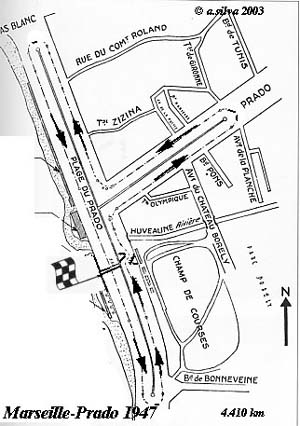 There was uncertainty about the presence of Italian teams until the last moment. There had been an agreement between the French Automobile-Clubs which were race organisers for the season, and representatives of the Italian teams on starting money. The Italian teams asked ACMP to re-negotiate the agreement before the race. ACMP had to give in at the last moment accepting a quite substantial increase in the starting money.
There was uncertainty about the presence of Italian teams until the last moment. There had been an agreement between the French Automobile-Clubs which were race organisers for the season, and representatives of the Italian teams on starting money. The Italian teams asked ACMP to re-negotiate the agreement before the race. ACMP had to give in at the last moment accepting a quite substantial increase in the starting money.
Four Ecurie GERSAC Delages were matched against three Ecurie France Delahayes, the Talbot MC of Chaboud and the newly rebodied Talbots of Marin (driven by Balsa), Scaron-Mouche and Rosier. The Bugattis of Falchetto and Trintignant - rendered beyond recognition in “modernized” bodies - were also there.
Scuderia Milan came with three Maserati 4CLs, the same that had been used in Jersey ten days before, for the same drivers. Raymond Sommer was driving the two-stage supercharged (on the Speluzzi system) example, Louis Chiron the old 1565 and a newer car for Nello Pagani. A fourth car – supposedly originally destined to Franco Cortese – did not show up.
Scuderia Ambrosiana took a newer Maserati 4CL for Gigi Villoresi, just returned from his South American triumphs. It had probably also a two-stage supercharged engine, this time on the factory system. Enrico Platé took one of his new Maserati 4CLs for himself whereas the one driven by Emmanuel de Graffenried was apparently entered by Ecurie Auto-Sport. Reg Parnell made his first appearance of the season on the continent with buddies David Hampshire and Fred Ashmore. Reg took two cars, the Maserati 4CL 1569 for himself, and ERA R1A, the very first ERA, to be shared by Ashmore and Hampshire. The list was closed by Ian Connell and Kenneth Evans in the usual 6CM/4CL Maserati. Connell gives us another bit of the flavour of the times “…I had arranged for all the tyres to be delivered there [in Jersey] by Dunlops. However I had entered the Maserati for a race… at Marseille. I had to charter an aircraft to take the tyres at once to France. On arrival at Marseille airport the Customs demanded duty on the tyres. After a bit of an argument I agreed to pay and this would obviously permit me to sell them before they were very worn. As they were of the sizes required by the many badly shod cars in France just after the war, they fetched a great deal of money so that Kenneth and I were able to stay at the Eden Rock Hotel for the Nice Grand Prix and have some money left over.”
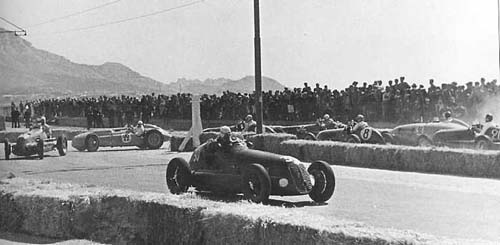
Marseille, the start. Villoresi from Sommer, Chaboud, Chiron, Platé, Pagani, Scaron, Connell.
Practice was dominated by the Maseratis, with Sommer – who had made fastest time – and Villoresi on the first row, Chiron on the second row, Platé on the third, while Connell and Pagani occupied the fourth. Chaboud, with the third time and an amazingly fast Scaron, sixth in an unusual – for him – big car, were the only non-Maseratis on the first rows. The Italians were of course heavily criticized for arriving late for practice, but evidently that had not been a problem. Falchetto blew his engine and was a non-starter for the race. As a curiosity, the organisers did not accept the entry filed by local boy Robert Manzon in his brand new Cisitalia D46!
On a very warm Sunday afternoon, Villoresi shot out in front of Sommer and the foreseen duel began. They were able to share fastest lap of the day before Villoresi’s engine expired on lap 9 and Sommer’s on lap 10. This left Chaboud in the lead. Before lap 27 all the Maseratis had retired with the exception of Platé, who was following Chaboud at a distance, and Michaud, who was closing the pack.
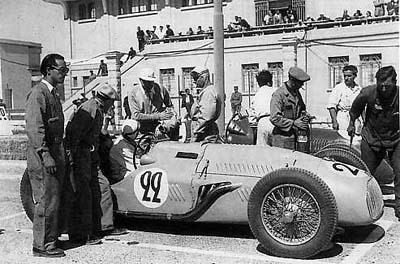
Marseille. Chaboud, the winner, on the starting line.
A terribly boring race ensued, with Chaboud circulating regularly at just two-thirds of his highest possible speed. He took an easy and popular victory, the second in a row for him and the Talbot MC, from the very consistent Platé, “a finer metteur à point than driver”. Out of nine finishers six cars were French, two were second-string Maseratis and the ninth was the old ERA, that had finished fifth. “A double mistake! Italians paid more for less prepared cars”, complained L’Equipe, then continuing: ”Necessary measures have to be taken. Let us reduce to 200 kms the distance of races dans la cité”, but “please let’s not call them Grands Prix”, added L’Action Automobile. Among the not very large attendance, M.lle Hellé-Nice was noticed, always “blonde et souriante”. The organisers felt in any case the burns of unsuccess, some of them even regretting the heat and final format of the previous year. So they did nothing when the date of the 1948 race, May 18th, was also booked for the return of the Monaco Grand Prix, resulting in an automatic cancellation of their race. The Grand Prix Internationale de Marseille would return in 1949, in the different setting of nearby Parc Borely.
The first drivers in the Championship table after the second race were: Chaboud 10.5, Louveau & “Levegh” 10, Achard 5, Sommer 4, and again L’Equipe wrote: ”Why not Roussillon?”
Villoresi confirme sa haute valeur…
A photograph in (AcA, January 1947) shows a proud group of notables in front of the Nîmes Roman Coliseum with a youthful Maurice Trintignant standing in the middle. The locals, on the right of the picture, had just received the committee of the ACF – pictured on the left - in charge of checking on the circuits for the races of the 1947 season. Trintignant was a high official in the organising Auto-Club, the AC du Gard.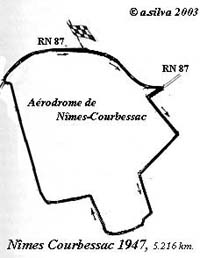 A Grand Prix was held in Nîmes in the early 30s on a curious track consisting of a back and forth on the divided lanes of a central boulevard with a couple of chicanes in each one. That layout was abandoned for 1947, when a track around the local airfield of Courbessac was chosen. It consisted of a piece of a Route Nationale (RN 87), parts of the airfield perimeter tracks and country lanes lined by suburban cottages and gardens. The surface changed from asphalt to concrete and… dirt, possibly the last occasion in which we find that kind of surface in European Grand Prix racing. Width varied from four to twelve meters. It was hailed as “a very fast and spectacular track which will offer every guarantee of safety both for spectators than for drivers...” or even “one of the more beautiful tracks in Europe”. They were barefaced lies, since it was intrinsically dangerous, technically insignificant and – no wonder – it was abandoned after this race.
A Grand Prix was held in Nîmes in the early 30s on a curious track consisting of a back and forth on the divided lanes of a central boulevard with a couple of chicanes in each one. That layout was abandoned for 1947, when a track around the local airfield of Courbessac was chosen. It consisted of a piece of a Route Nationale (RN 87), parts of the airfield perimeter tracks and country lanes lined by suburban cottages and gardens. The surface changed from asphalt to concrete and… dirt, possibly the last occasion in which we find that kind of surface in European Grand Prix racing. Width varied from four to twelve meters. It was hailed as “a very fast and spectacular track which will offer every guarantee of safety both for spectators than for drivers...” or even “one of the more beautiful tracks in Europe”. They were barefaced lies, since it was intrinsically dangerous, technically insignificant and – no wonder – it was abandoned after this race.
The big news of the day was that the winner of the two previous French races, Eugène Chaboud, had left Ecurie France, when their boss Vallée had decided to entrust the Talbot-Lago MC to Louis Chiron. Understandably Chaboud did not want to be demoted to the wheel of Lord Selsdon’s Talbot T26 90202, which had just been hired by Vallée for the season. Comments were disparate, but, curiously enough, Chiron’s behaviour in the whole matter, that appears in retrospect as blameful and is treated as such by every historian, was not criticized at the time. On the contrary, Maurice Henry writes that in Perpignan “[Chiron] had contributed in a large portion [to Chaboud’s victory] by organizing with the hand of a master the Ecurie France pits…”. On the other side, it was remarked: “Ecurie France was responsible for the loss of several points for the Championnat de France by Chaboud, having entrusted the Talbot to Chiron.”
One of the few comments with which we can agree today is that a “magnificent field” entered the race. Four Ecurie GERSAC Delages were to compete against the two Ecurie France Talbots, two ex-Ecurie France Delahayes and three Talbot Spéciales. The ex-Grignard Delahaye arrived with the new owner Meyrat at the wheel, and Achard’s Delahaye 155 was driven for once by “Levegh” who had seen his Delage entrusted to local boy Trintignant. The French Maserati patrol, with Sommer in the two-stage Milan car, had acquired “Raph”, just arrived from South America. The two SIMCA-Gordinis entered for the Grand Prix were preserved for the voiturette race, instead.
Foreign opponents were headed by Villoresi’s Scuderia Ambrosiana Maserati 4CL and Enrico Platé also arrived from Italy in a new Maserati. Reg Parnell came with the Maserati 4CL, 1569, and the ERA R1A for Fred Ashmore. Raymond Mays crossed the Channel too with ERA R4D as did “B Bira” with his new Maserati 4CL, 1584.
We do not know much about practice, except that Villoresi made the fastest lap from Chiron and Sommer.
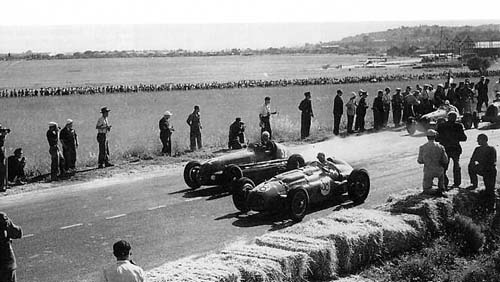
Nîmes, the start: Chiron and Villoresi in first row.
Sommer can be seen in second row fiddling with the fuel switch.
The start of the race was scheduled for 4 pm, but could not take place before 5. That was a cause of worries, since the 360 km-long race would last for over 3 and one half hours. In any case Villoresi took the lead after two laps from Chiron. Sommer had forgotten to open the fuel switch and was off a slow start. He came by in 23rd position after one lap. Chiron knew perfectly well that Villoresi would have to stop twice for fuel during that never-ending race and adjusted his speed accordingly, Sommer was able to lift himself to second position by lap 30th from Chiron, “Raph”, Parnell, “B Bira”, Platé, Etancelin, Mays, Ashmore. Villoresi’s first stop looked pretty much as a Scuderia Milan pit stop, even though he had switched to Scuderia Ambrosiana. It lasted forever so Chiron took a healthy lead, but spice was added to a very boring day came when Chiron made a very uncharacteristic mistake. He took a too wide exit from a turn and a wall grazed one side of the Talbot. Chiron had to stop at the pits to check for damages and a wheel was replaced. Meanwhile Villoresi was back in the lead with such an advantage that his second stop did not cause any change in the order. Reg Parnell was running steadily in third position from Mays. An exhausted Villoresi won under artificial light by one and a half minute from Chiron, two laps from Parnell, five from Mays and the sturdy Delahaye of Pozzi and was greeted by a very pretty Miss Ciné-Monde. He set the fastest time of the day, closely followed by Sommer. The best supercharged cars and the Ecurie France Talbots were well within 10” from them.
The meeting was a financial washout for the Automobile Club du Gard. In order to recuperate the losses it was decided to organize a raffle with a new Citroën 11 as prize. The penury of new cars made the raffle an instant success nationwide. The draw took place over a year after the Grand Prix and was followed by all the national press. The prize was handed to a happy family in a public ceremony in the Paris premisescs of the ACF.
After this race, the Championship table showed as follows: Chaboud 11.5 pts, Louveau & “Levegh” 11, Achard 6, Pozzi & Sommer 5. Chiron’s status in this matter was uncertain: he held dual citizenship, but his licence was Monegasque. No decision had been made yet.
L’ Autodrome de Monthléry – on the Paris Orléans National Road, 25 kms from Paris – was completed in 1924. It had been the idea and the work of one man, Alexandre Lamblin, a newspaper publisher and a manufacturer of radiators. He had bought an estate of 5,000 hectars and spent 3 milion Gold Francs on the project, an enormous sum. He wanted to build a test facility to help automobile technology go beyond its limits. A banked speedway was built together with a road course to mimic normal roads.
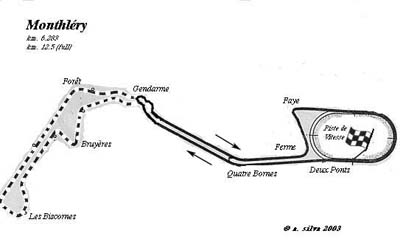 The Autodrome de Monthléry had reopened after the war on an icy Sunday, February 16th, 1947. The testing ground for French manufacturers, the proving ground for clubs and the preferred home for long distance records in Europe was given back to the sport. The track, which had been purchased by the military in 1939, had become during the war a camping ground for gypsies and a prisoner camp, among other uses, ending as a fuel depot for the Allied troops. The wooden grandstand had long gone, used as combustible for heating the barracks. A technological agency of the Defense Ministry, the C.T.A. et C. (Centre Technique de l’Automobile et du Cycle) struck an agreement with the military to run the civilian side of the track and the sorrounding grouns in exchange for repair and maintainance expenses, not an easy task. The work was finished by 1950, in any case, with the building of special tracks for testing grounds for car manufacturers.1
The Autodrome de Monthléry had reopened after the war on an icy Sunday, February 16th, 1947. The testing ground for French manufacturers, the proving ground for clubs and the preferred home for long distance records in Europe was given back to the sport. The track, which had been purchased by the military in 1939, had become during the war a camping ground for gypsies and a prisoner camp, among other uses, ending as a fuel depot for the Allied troops. The wooden grandstand had long gone, used as combustible for heating the barracks. A technological agency of the Defense Ministry, the C.T.A. et C. (Centre Technique de l’Automobile et du Cycle) struck an agreement with the military to run the civilian side of the track and the sorrounding grouns in exchange for repair and maintainance expenses, not an easy task. The work was finished by 1950, in any case, with the building of special tracks for testing grounds for car manufacturers.1
An exhibition run of most of the racing cars existing in France at the time – except the Ecurie France ones that were in Sweden for the ice-races – took place that day under a sprinkling of snow.2 Raymond Sommer took the big “monoplace” Bugatti 4.7L last seen at the Bois de Boulogne in 1945, to a lap at 212.353 kph on icy track.
The first post-war meeting was held on June 8th, the same day of the Swiss GP. Four races were run, two for sports cars and two for racing cars, reserved to members of the ACIF (Automobile Club de l’Ile de France) and of the AGACI. Cars and drivers were not all of top quality. In some cases the meeting was their first race.
Ciroux won the big sportscar class from Vedor and Parisian Paul Bodet in a Maserati the voiturette race, from Pr. Igor’s Gordini. It was then the turn of the big racing cars event where the drivers in the list of entrants were mainly of good class. Among the six cars which took the start there were two up-to-date ones, Edmond Mouche’s Talbot Spéciale 82930 and Maurice Varet’s brand new 3L Delage, chassis 880005. Ecurie GERSAC was on the road with the team’s other four Delages. 880005 had been left behind in Paris on the understanding that it would be shipped if a replacement car were needed. Team mechanic Varet waited anxiously until race Sunday came. He did not have many chances to drive, but each time he could, he was able to show excellent qualities. The 45-minute race was an exciting one. Mouche started ahead with his more powerful car (200bhp vs. 140). At each lap Varet would overtake him at La Ferme, kept the lead at Faye and was again passed on the banked track. In the last lap Varet took a different trajectory on the banking, staying lower and in the middle. Mouche could not overtake him this time and Varet won by three tenths of a second. Giuseppe Morra’s Bugatti came in third from Pierre Larrue’s rather touring Delahaye.
The Grand Prix des Remparts for voiturettes took place on June 15th. It qualified for the fourth round towards the French Championship. After this, the table showed as follows: Chaboud 11.5, Louveau, “Levegh” & E. Martin 11, Manzon 8.
A true tour-de-force had started with the GP of Europe at Spa on June 29th: races would follow at a devilish pace on the 6th, 13th, 20th of July at Reims, Albi, Nice, and the 3rd and the 10th of August at Strasbourg and St.-Gaudens. The first of these meetings saw the return of racing to Reims, on the extremely fast track which had superseded Monthléry as the home of the Grand Prix de l’A.C.F. in 1938 and 1939.
 In March 1947, Eugène Chaboud had accepted an invitation from Toto Roche, the famous and colourful organiser of the Reims race, to bring his Delahaye to the circuit. Roche needed advice as to what interventions were needed to bring the circuit back to racing form. The very modern facilities, pits and grandstands, were still intact, only resurfacing was needed after the passage of tanks from both sides on R.N. 31. The result was so successful that Motor magazine described the track as “in marvellous condition… [and] …smooth as a billiard table”.
In March 1947, Eugène Chaboud had accepted an invitation from Toto Roche, the famous and colourful organiser of the Reims race, to bring his Delahaye to the circuit. Roche needed advice as to what interventions were needed to bring the circuit back to racing form. The very modern facilities, pits and grandstands, were still intact, only resurfacing was needed after the passage of tanks from both sides on R.N. 31. The result was so successful that Motor magazine described the track as “in marvellous condition… [and] …smooth as a billiard table”.
Everything was ready by the beginning of July for what was going to be the more international race of the series. Bob Gerard and Peter Whitehead arrived directly from Spa. Gerard was still accompanied by T.C. Harrison as second driver. The pair had just finished fourth at Spa in Gerard’s ERA R14B, whereas Whitehead came in his ERA R10B. Leslie Brooke entered the third “upright” ERA in the race, ERA R7B, for Fred Ashmore. The arrival of both ERAs E-Type caused some sensation but “neither car arrived to the line in proper raceworthy order”. Brooke’s car, GP-2, had been sent upon completion directly to Indianapolis where it failed to qualify, since the gearbox did not wish to work properly. The problem with the gearbox could not be fixed before Reims. Reg Parnell had bought the 1939 example, GP-1, from Whitehead after the Jersey race when the Yorkshire gentleman farmer decided that he’d had enough of that car. Parnell was starting “unsupercharged” since that component had disintegrated during practice. Ian Connell and Kenneth Evans arrived in the Maserati, which soon developed an engine ailment. From Italy, Enrico Platé took with him two recently acquired cars, one for himself, the second for Swiss Christian Kautz. Kautz, who lived and worked in the USA, was spending his European vacation and had planned to enter the European and Reims Grands Prix. He wanted his car meticulously prepared by Platé, since he had to return overseas after the race and was not going to get another chance. Scuderia Ambrosiana too arrived for the first time with two cars. Drivers were Luigi Villoresi and newcomer Alberto Ascari. The Gueux circuit was witnessing the quiet debut in Grand Prix racing of one of the fastest drivers in history. The French Maseratis were driven by “Raph“, Sommer in his personal blue car “festooned with extra fuel tanks” and Louveau, in a one-off appearance in a 4CM. The two Ecurie France Talbots, MC and 90202, were accompanied by Rosier’s and Mouche-Scaron’s Spéciales. Louveau’s Delage, driven by Trintignant, and the Delahayes of Pozzi and Chaboud completed the field.
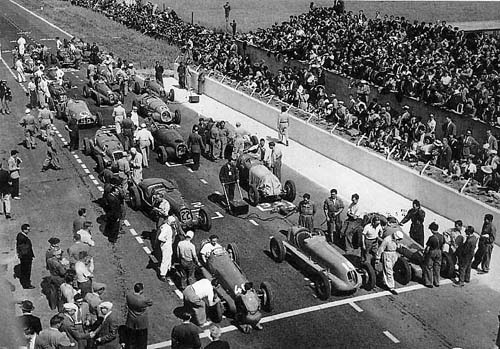
Reims, preparing for the start.
Kautz showed that Platé had made a good job in preparing his car. He took pole by a large margin from Louveau and Sommer, but half of the field, including Villoresi and Ascari, had arrived late for official practice.
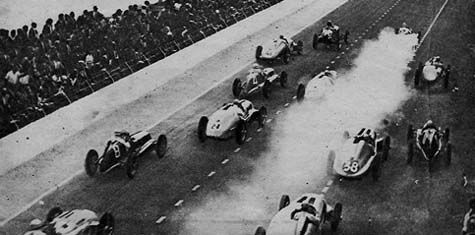
Reims, after the start. Villoresi, #8 left, and Ascari, #10, extreme right,
have already climbed through most of the field.
Kautz was off a good start and led the race until Villoresi came thundering through from behind, took the lead on lap 3 and then immediately stopped at the pits to change plugs. It took took Gigi until lap 21 to regain the lead. Sommer and Ascari were following and for a few laps the young Milanese was in second position. He had to stop too, and was fourth when the engine suffered a very costly blow-up on lap 30. The functioning of Sommer’s car was erratic and after a stop on lap 10, he struggled with a cracked chassis until he retired on lap 40. Chiron was following cautiously as usual with the confidence given by knowing that no refuelling stop would be necessary. Chiron was fourth on lap 10, after Sommer’s stop, third on lap fifteen, after Ascari’s stop and finally second on lap 33 when Villoresi’s engine blew up too and Kautz was back in the lead. On Kautz’s second stop, Chiron briefly took the lead, but the Swiss was on the best day of his career and won by two and one half minutes from Chiron. The Gerard-Harrison ERA was third, another beautiful effort after Spa. “It would be … nice to think that … [the results of Gerard-Harrison] … were as much appreciated at home as the … results of a half-mile sprint.” The other French former sports cars looked hopelessly slow on the fast Champagne track. They were 20” slower than the Maseratis in each lap. Yet some of them plodded home right behind Gerard-Harrison.
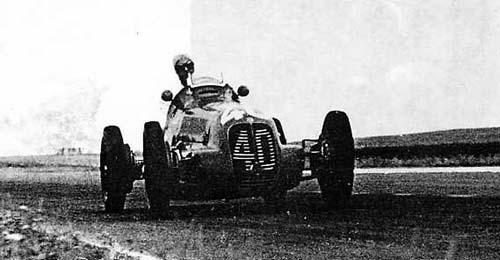
Kautz, the winner, on the swerves “du Calvaire” towards Gueux.
It is of interest to compare the speed of some of the same cars against pre-war perrformances. The Talbot MC was qualified by Mays in the 1939 GP in 2’53”7. No time during that race is recorded. During the race Chiron’s best time was 2’58”9. Giraud-Cabantous’ 90202 had been driven by Carrière in the 1938 GP with a qualifying time of 2’57”0 compared with 3’05”1 set by Giraud-Cabantous during the race in 1947. Fastest lap in the 1939 voiturette race was set by Wakefield’s Maserati 4CL in 2’56”2, here by Villoresi in a similar car in 2’58”2. Pole position was set by Wakefield in 2’51”7, here by Kautz in 2’51”1. The fastest time set by an ERA in 1939 was Pollock’s qualifying time, 3’05”6. In 1947 was set by Gerard during the race in 3’05”1. It has to be noticed that fuel was free in 1938/39, whereas now was provided by the organisers. (Click here for a lapchart of the race.)
After the race, Chaboud increased slightly his lead, and Chiron moved into contention. We had: Chaboud 15.5 points, Chiron 13, Louveau 12, “Levegh” & E. Martin 11, Sommer 8.5, Manzon 8, Pozzi 6.5.
Villoresi favori à Albi… Louis Rosier triomphe
The enterprising members of the Moto-Camping Club Albigeois were not idle during the winter. An under-pass to reach the paddock was built. The footbridge from the stands was moved in another location and a new one was built in St.-Juery. The main grandstand also got a roof. All had been the work of the Club members as usual. The decision to build the under-pass had caused heated discussions and a couple of members resigned as a consequence. As much as divergences are hot, they go off the boil pretty soon in that land of sharp colours and contrasts, as beautifully described in Daudet’s Tartarin. The renegades joined the rival Aéro Club, but came back to the MCCA pretty soon, undoubtedly creating the occasion for a gargantuan dinner to fete the prodigal sons.
Yet, in the immutable Albi landscape, a singular happening took place. The race was not going to be run under the usual format of two heats with final classification by aggregate times, but was a normal 350km long Grand Prix. It was an unexplained break in the tradition, which was going to remain isolated.
The caravan of cars and drivers had to cross the whole country fron North to South to reach Albi. Very few cars arrived on Friday for the first practice session. The Ecurie France Talbots and Ascari and Platé’s Maseratis did not arrive at all. Starters would have been scarce if the organisers had not invited the best voiturettes: SIMCA-Gordini, Cisitalia D46s, Bonnet and Darl’Mat.
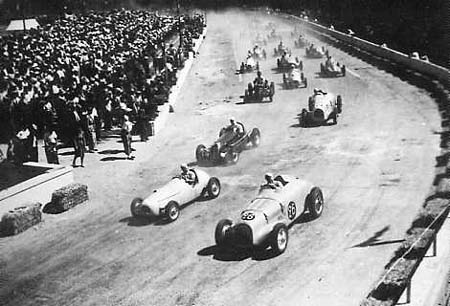
Albi, the start. Rosier from Wimille, Louveau, Mouche, Brooke, Trintignant,
Bonnet, Chaboud, Sommer, de Cortanze.
Equipe SIMCA-Gordini came with four cars for Jean-Pierre Wimille, Maurice Trintignant, “Pr. Igor” and Le Patron himself. The Cisitalias had been just trounced by the SIMCAs at Reims. Raymond Sommer had headed the patrol of Italian cars there and was deeply dissatisfied with their performances. A few laps more at Albi convinced him that the the Cisitalia was too underpowered for any kind of racing on fast tracks, not to mention Grands Prix. The wily Amédée detected Sommer’s dissatisfaction and offered his own car, which he had just qualified in 12th position. Sommer reciprocated with a most amazing performance. The top Cisitalia D46s were entered by Scuderia Ambrosiana with motorcycle ace Dorino Serafini and Scuderia president Eugenio Minetti. Alberto Ascari drove the latter car in the race, a fact not mentioned by most sources. We do not know if Minetti actually shared the drive. Loyer, “Robert”, Schell and Marius Porta, in Manzon’s car, drove four “French” Cisitalias. The voiturette line-up was completed by de Cortanze’s Darl’Mat-Peugeot on Amilcar chassis, and by René Bonnet’s DB-Citroën, two reasonably fast cars. Pre-war ace Pierre Veyron would share the drive with de Cortanze.
Five Maserati 4CLs took the start: the Naphtra Course pair with “Raph“ in 1588 and “Levegh” in 1571, Villoresi in Scuderia Ambrosiana 1586, Louveau in a Scuderia Milan car, Parnell in 1569, while Ascari in 1583 and Platé in 1585 were non-arrivals. Evans and Connell entered the old Maserati 6CM/4CL. The ERAs were Parnell’s R1A with Fred Ashmore at the wheel and Brooke’s R7B. The opposing French unsupercharged cars looked ancient and hopeless. They numbered Achard’s Delahaye 155, Mouche’s and Rosier’s Talbot Spéciales, Pozzi’s and Chaboud’s Delahayes 135CS.
Louveau had been the fastest in practice, but Brooke took the early lead from Wimille and Rosier. Villoresi who had started in last position came charging from behind as usual and by lap 4 was leading already from Brooke. Wimille, who ran third, was out of the race very soon. Villoresi seemed very fast compared to rest of the field, but his fastest lap of the race of 3’26”4 was substantially slower than the one set by Gigi the year before in 3’22”3, only 3 tenths slower than what Johnny Wakefield had been able to do in a similar car, but on free fuel, in 1939. Opposition was not ferocious in 1947, so Gigi looked set to record an easy victory. At 25% of the race, on lap 10, Villoresi led from Levegh, Brooke, Chaboud, Rosier and Sommer. Scuderia Ambrosiana looked as if it had inherited the poor pit organization that was the Scuderia Milan trademark the previous year. Villoresi was not signalled that he was expected to refuel by lap 18, was sent on to another lap and ran out of fuel a long way from the pits. Another pitiful Maserati day was taking shape. “Raph” had never been a factor, poleman Louveau was running on three cylinders from the very beginning, Parnell’s race lasted one lap and a curious incident happened to Connell: “At terribly hot Albi the Maserati was performing very well. …on arriving at a very sharp corner a wasp got down my open shirt… and started to sting me. Driving with one hand and trying to kill the wasp with the other, I found another car broadside across the road and blocking it so that I had to carry on down the escape road, stalling the engine in the process. An ambulance rushed up on seeing my frantic gestures and delt with the stings. Unable to start the Maserati I had to leave it…”
Only “Levegh” was left. He was driving the victorious car from the year before and was leading from Sommer in the tiny SIMCA-Gordini, who was “urging the car around, on the thin line separating genius from madness...”, Chaboud, Rosier, who was already 3 minutes behind on lap 18 and Pozzi.
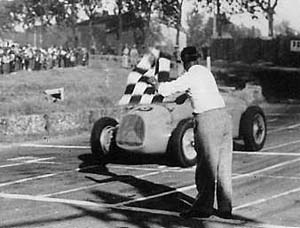 Rosier had passed Chaboud on lap 25th, when he was only 30”8 behind “Levegh” and 20” behind Sommer, since the leader had had to stop to refuel. At lap 30 the leading times were “Levegh” 1:32’41”1, Sommer 1:33’57”5, Rosier 1:34’01”3. “Levegh”’s engine swallowed a valve on lap 33 and Sommer had to refuel too. Rosier was then cruising to a most unexpected victory in a car that nine years before had been a beautiful Grand Touring cabriolet. It was Louis’ first international win, but by no means the last, all the more important ones being obtained by means of the same careful exploitation of the Talbot-Lago engine’s reliability and notorious temperance.
Rosier had passed Chaboud on lap 25th, when he was only 30”8 behind “Levegh” and 20” behind Sommer, since the leader had had to stop to refuel. At lap 30 the leading times were “Levegh” 1:32’41”1, Sommer 1:33’57”5, Rosier 1:34’01”3. “Levegh”’s engine swallowed a valve on lap 33 and Sommer had to refuel too. Rosier was then cruising to a most unexpected victory in a car that nine years before had been a beautiful Grand Touring cabriolet. It was Louis’ first international win, but by no means the last, all the more important ones being obtained by means of the same careful exploitation of the Talbot-Lago engine’s reliability and notorious temperance.
Chaboud was the victim of the unforgiving Albi sun (over 40 degrees of temperature) and left the road on the last lap because of a heat stroke, his car overturning in a ditch. In this way Sommer finished second two minutes behind the winner at the wheel of an 1100cc unsupercharged car preceding Pozzi’s Delahaye who had survived an early excursion into the straw bales. Loyer won the Cisitalia race finishing fourth overall from the Scuderia Ambrosiana car. Italian sources give either Ascari or a shared drive Ascari-Minetti for it, whereas the young Milanese prodigy is never mentioned in non-Italian sources, undoubtedly still a complete unknown on the other side of the Alps. Trintignant’s Gordini finished sixth from the two 2L French cars of de Cortanze-Veyron (Peugeot engine) and Bonnet (Citroën engine).
The massive presence of voiturettes could indicate that a special classification, wich would have seen Sommer first, was foreseen, but no trace of it was found. Tragedy struck when Achard’s Delahaye 155 lost a wheel, which flew into the grand stand. A lady spectator was killed and another injured in the frightful accident.
The choice of adjectives in the commentaries after the race was complete: Louis Rosier was a “courageous and skillful” as well as a “consciencious and steadfast” driver. Rosier’s future career will show that for once adjectives were highly appropriate.
After the Grand Prix d’Albi, the Champioship looked within everybody’s reach: Chaboud 16.5 points, Sommer 14.5, Rosier, Louveau & Chiron 13, “Levegh” 12, Pozzi 11.5, E. Martin 11.
Rozier [sic] à Nice essayera de confirmer sa victoire au GP d’Albi
[Rozier will try to confirm his Albi victory at Nice]
There was uncertainty about the list of starters of the Grand Prix Internationale de Nice until three days before race Sunday. It was the fourth race in four consecutive week=ends. The preceding ones, held on the very fast tracks of Spa, Reims and Albi, had put men and machines under a lot of pressure. Yet, an excellent field still turned out for what was going to be the last Grand Prix on the Promenade des Anglais. Many different reasons certainly contributed to its demise, not least the re-birth of the Grand Prix in nearby Monaco that was going to occur the following year. The local Automobile Club had moved the date of the race to mid July as in the prewar editions. The necessity of closing the centre of town for a week during the sunmmer season was doubtless another reason for the end of the series.

Nice, Ascari and Villoresi.
The two Ecurie France Talbots arrived in Nice and were faced by the best Maseratis available: the Ambrosiana cars for Ascari and Villoresi, Sommer’s Milan two-stage supercharged car, “Raph” and de Graffenried in recent examples with “Levegh”, Louveau and Parnell in older ones. Evans and Connell started the last race in their Continental racing season: the front engine mountings and the chassis had cracked, so the car was returned to Sommer after the race. Swiss Adolphe Mandirola and Fred Meyer, a driver from Zürich who had entered a Bugatti in the Prix du Bremgarten early in June, complete the Maserati drivers. Brazilian Chico Landi is listed as Meyer’s reserve. The E-type ERAs had returned to England whence came in turn the older models of Brooke, R7B, and Parnell’s, R1A, driven by Fred Ashmore. Brooke’s car had broken the crankshaft at Albi and a shortage of parts meant he had had to fit an 1100 cylinder head. R1A too was in 1100cc form.
The Maseratis, with Villoresi, Sommer - whose car had arrived late on Saturday – and Ascari, dominated practice.
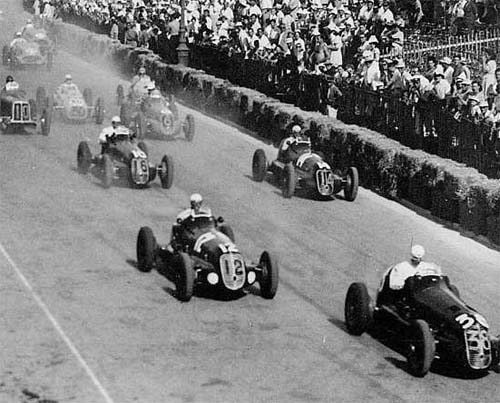
Nice, the start. Sommer from Villoresi, Ascari, de Graffenried, Parnell, Ashmore, Chiron, Wimille.
On the first lap Sommer came by leading from Ascari, Villoresi, de Graffenried, Chiron, Wimille. Villoresi soon overtook his younger teammate and a very close battle for first developed between Sommer and Villoresi. At lap 10 Sommer led from Villoresi, Ascari, Chiron, “Raph”, “Levegh”, Parnell, Wimille and Ashmore. Chiron was already 1’04”5 behind Sommer. Around the 20th lap both the front running cars suffered ignition trouble. While Villoresi’s pitstop was for a normal change of plugs, Sommer was enduring more serious problems. Plugs were changed and a “highly gesticulatory conference took place over the blower”. Sommer was sent off anyway, but stopped on the backstretch to estinguish a small fire and was then unable to restart it. He pushed the car heroically under the blazing sun back to the pits, but to no avail since the problems were irrepairable. At lap 30 the order was: Villoresi, Ascari, Chiron, “Levegh”, Parnell, Wimille Ashmore. Chiron was 2’09” behind Villoresi, but only 21” behind Ascari and was slowly getting closer. He was only 12” behind when he steered sharply into the pits. The head gasket had just burnt out. It was only the 38th of 100 laps. It was then “Levegh”’s turn to retire followed by Parnell soon after; when it happened they were both in third position. Villoresi and Ascari reduced speed, allowing Wimille to catch Ascari. “Far from using the whole road in the classic style, [Wimille] was hurling the little car the inside all the way, with what appeared to be practically no reduction in speed.” The French ace was about to teach a lesson to the Italian newcomer. After having pushed him from behind for 15 laps, he passed Ascari in front of the pits, just to be soon repassed towards the first hairpin. Ascari was too late for braking there, so Wimille passed him for good on the return leg. Ascari’s car soon developed ignition problems and had to stop to change plugs. Parnell, in Ashmore’s car, went ahead of him, and so it ended, with the cars lapping in a careful procession. This caused the winner’s average speed to be slower than the previous year: 104.386 kph. vs. 103.057 kph. Villoresi bettered his fastest lap from 1’44”8 to 1’44” and the pole position time from 1’45” to 1’43”3. In the hands of Ecurie France, the Talbot MC had become a much faster car, its best lap time during the race going down from 1’50’1 to 1’44”7. The Delahayes 135 of Chaboud and Pozzi are the only other two cars that can be compared between 1946 and 1947. Chaboud’s best lap time went down from 1’56” to 1’54”, whereas Pozzi’s decreased dramatically from 2’07”1 to 1’55”4. Of course Pozzi’s car was lighter with the new body, much better prepared and the driver had gained a lot of experience.
If possible the Championship table was an even closer affair than the week before. It showed: Chaboud 17.5 points, Sommer 16.5, Pozzi 14,5, Louveau, Chiron & Rosier 14, “Levegh” 13, E. Martin 11.
Strasbourg a conduit Rosier vers le Championnnat…
[Strasbourg has led Rosier towards the Championship]
The return of a Grand Prix to Alsace for the first time since the 20s was not the forerunner of a new series, but one more of the kind of the one-off municipal races of the year before. It was a not lucky one either, since a motorcycle in the race for the two-wheelers hit the chief of the organizing committee, a M. Freiß, who had to have a leg amputated. The track was dangerous, with cobblestone sections, tramway rails and pits and grandstand on the outside of a narrow curve, made even narrower by a lot of straw bales. It was a miracle that the number of accidents was limited, although more severe ones happened during the motorcycle races.
Most of the drivers showed up very late, which caused L’Equipe to bemoan the fact that “drivers do not like practice”. Wimille, for instance, had his SIMCA-Gordini qualified by mechanic Adrien Alin. In any case the best available Maseratis were all there, with the exception of Sommer’s car, pitted against the biggest variety of French unsupercharged cars ever seen, with the only notable absentee being the Ecurie France Talbot MC. A novelty was the inexpressibly ugly Talbot Spéciale 90203 of Pozzi’s. Eugène Chaboud arrived with the usual Delahaye and with a Veritas, the car built by Ernst Loof on BMW components. At that stage of Loof’s activities, it should be presumed that the car was the early Veritas prototype. German cars were not allowed to race internationally, so the Veritas, which was built in the French-occupied zone of Germany, was announced to have been built there as a French car, with French capital and technicians. The Alsatian public, for whom the German issue was no joke, was not fooled and car and driver were heavily booed when they showed up for practice. Luckily the car was too slow and the incident was quickly closed.3 A total newcomer was the Swiss from the Canton de Vaud, Anton Branca, in an old Maserati 4CM shared with Fred Meyer.
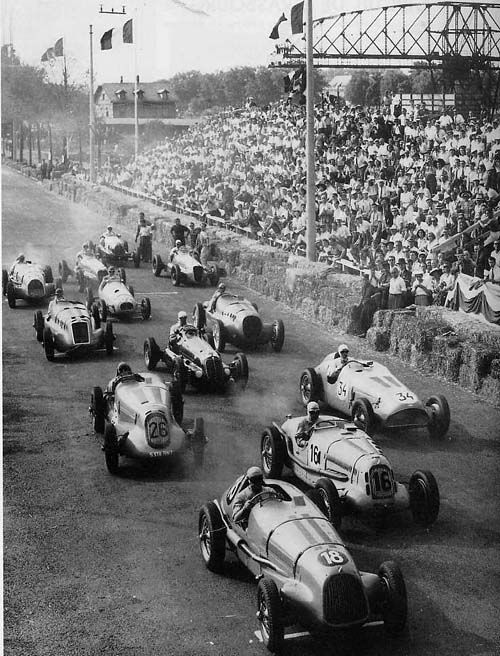
Strasbourg, the start. #18 Rosier, Talbot 90111. #16 Giraud-Cabantous, Talbot 90202.
#26 Meyrat, Delahaye ex-Grignard. #34 Chaboud, Delahaye 47932. Louveau.
Varet, Delage 880004. Brault, Delahaye 46835. Wimille, SIMCA-Gordini 07GC.
Mouche, Talbot 82930. “Raph”, Maserati 4CL 1588. “Levegh” Maserati 4CL 1571.
Branca, Maserati.
Villoresi was in great form as he had shown in the previous races and took immediately the lead after starting from pole. Ascari and Chiron, who had gone to Strasbourg without a car since the Talbot MC could not be made ready for the race, followed him. As a matter of fact, Enrico Platé had entrusted one of his cars to Chiron. The bet was, as always, on how many Maseratis would finish the race. Villoresi soon had to stop for the customary change of plugs. Chiron was then in the lead, followed by Ascari. Chiron’s Maserati did not last for very long nor did “Levegh”’s. Ascari was then leading a Grand Prix for the first time. It lasted until valve troubles stopped that momentous happening, not much remarked by the contemporary press, it must be said.
The lead returned to Villoresi and after Wimille’s Gordini had retired due to a lack of brakes, Yves Giraud-Cabantous found himself in a surprising second position, although his Lord Selsdon/Ecurie France Talbot-Lago T26 was 8” per lap slower than Villoresi on average. When Gigi realised that the last remaining challenge had evaporated with the retirement of Wimille, he slowed down a lot so Yves was not lapped. The other finishers, including the Maseratis of Louveau and “Raph”, were much slower than him, more than ten seconds a lap with respect to the winner. Thus Rosier – who had finished third – took the lead in the Championship: Rosier 19 points, Chaboud 18.5, Louveau 18, Pozzi 17.5, Sommer 16.5, Chiron 15, “Levegh” 13.5, E. Martin 11, Giraud-Cabantous 10.5.
Chiron en tête du Championnat…
St.-Gaudens is a sleepy little town situated at the foothills of the Pyrénees where the Garonne river valley leaves the ridges and starts its course towards the flat part of the Midi. There, a very energetic man who was later elected senator had started to organize a week of motoring events during the summer to promote the local spas. His name was Eugène Azemar. He was a man of letters and a motoring enthusiast. In 1925 he took his ideas to the Automobile Club du Midi in Toulouse in order to get support for the organisation of a Grand Prix as the top event of the motoring week. A 25 km-long course was designed. It followed RN 117 on the northern bank of the Garonne River with a 12-km long straight. 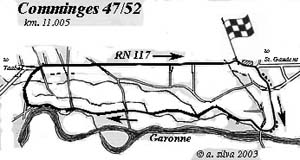 This seemingly endless straight was going of course to become the more famous landmark of the circuit. A parallel course was set on the Southern bank using sweeping local roads. Two bridges and short segments of local roads joined the two sections. It was a fast and technically impeccable circuit, but it was too long to be marshalled effectively and the closure of the two bridges affected the local traffic too much. The wonderfully named Association of the Grand Stand of Comminges (La Société des Tribunes du Comminges) raised the money necessary to build a new road, closer to the northern bank than RN 117, purely for the purpose of racing. The Circuit du Comminges became in this way one of the so-called semi-permanent tracks, like Spa or Le Mans for instance. Money was plentiful enough to build new banks on the natural amphitheatre located on the outside of the first curve, where over 7,000 seats were provided with views stretching far away from the track down the Garonne valley. A tent, borrowed from the local horseracing track, covered the stand. Comminges had seen the last race in France before the war, when the new prodigy Le Bègue in a Talbot had pipped Wimille’s Bugatti at the finishing line.
This seemingly endless straight was going of course to become the more famous landmark of the circuit. A parallel course was set on the Southern bank using sweeping local roads. Two bridges and short segments of local roads joined the two sections. It was a fast and technically impeccable circuit, but it was too long to be marshalled effectively and the closure of the two bridges affected the local traffic too much. The wonderfully named Association of the Grand Stand of Comminges (La Société des Tribunes du Comminges) raised the money necessary to build a new road, closer to the northern bank than RN 117, purely for the purpose of racing. The Circuit du Comminges became in this way one of the so-called semi-permanent tracks, like Spa or Le Mans for instance. Money was plentiful enough to build new banks on the natural amphitheatre located on the outside of the first curve, where over 7,000 seats were provided with views stretching far away from the track down the Garonne valley. A tent, borrowed from the local horseracing track, covered the stand. Comminges had seen the last race in France before the war, when the new prodigy Le Bègue in a Talbot had pipped Wimille’s Bugatti at the finishing line.
Two concurrent car races were organised for the first post-war meeting at Comminges, the Grand Prix with a special classification for voiturettes together with the usual motorcycle races. Forty-two entries were filed and it is reported that the organisers had to refuse some applications. Thirty-six cars showed up for practice. Among the more notable absentees, Sommer’s two-stage Maserati, the never ready Guerin-de Coucy car and Luigi Chinetti who had disembarked the Talbot-Lago MD 90131 which he had shipped from the USA only on the Friday before the race. The Ecurie France Talbots were present though together with Chaboud in Pozzi’s Talbot Spéciale 90203. Pozzi’s assessment was that Chaboud’s chances of winning the Championship were higher than his own, although he was very well placed in the table. Wimille was there too in a SIMCA-Gordini but engine troubles prevented him from starting. Italian, Swiss and British opponents were not numerous but very strong. Ascari and Villoresi came from Italy with the Scuderia Ambrosiana Maseratis. Dorino Serafini in his first Grand Prix was driving a Scuderia Milan Maserati after having made some experience in Cisitalia D46s. Adolphe Mandirola, Fred Meyer and Anton Branca arrived from Switzerland in more or less outdated Maseratis together with Emmanuel de Graffenried in a much newer Platé Maserati 4CL. Rolf Kessler, the son of Hans, a well-known pre-war hillclimb specialist from Zürich, completed the Swiss entries in an old Bugatti. Fred and Joe Ashmore came from Britain with Parnell’s ERA R1A and Maserati 4CL, 1569, that Reg had reluctantly loaned to Joe. The voiturette race saw all the six French-owned Cisitalia D46 present, with Loyer, Schell, de Saugé, Boyer, Manzon and “Robert” opposed by de Cortanze’s Darl’Mat, Chardonnet’s BMW 328 sport and, above all, Eugène Martin’s BMW Spl.
Villoresi and Ascari dominated practice. It seemed that everything was set for another Sunday spent guessing how many Maseratis would go the distance and what would the placing of the best unsupercharged French car be as a consequence,4 but the atmospheric elements saw that the Grand Prix du Comminges 1947 would become a most dramatic race.
Villoresi stormed in front of the pack followed by Serafini who after a few laps started in chase of Gigi. Serafini, who was showing great promise, had set the fastest lap of the day and was closing to Villoresi, when he was the victim of a ghastly accident. The steering wheel came off together with the entire steering column. Serafini was relegated to the role of passenger and was powerless as the car encountered a row of lime-trees, which lined the road in the customary French style. The car finally hit one head-on and caught fire. Serafini suffered multiple fractures to his ribs, arms and legs and was severely burned. He survived but he was out of racing for over one year. Joe Ashmore had been the first retirement of the race. During the first lap he was hit from behind. His car turned over and he too was taken to a hospital with broken ribs. Parnell’s misgivings had been confirmed by the facts. Intermittent local showers were starting to fall, taking the drivers by surprise because of the length of the track. Boyer, Huc, Martin, Larrue and Fred Ashmore, who overturned the car in an irrigation ditch, all crashed. By half race Villoresi was comfortably leading from Chiron, Ascari, Rosier, Giraud-Cabantous, de Graffenried, Chaboud, “Raph”, Loyer, de Cortanze. His margin was such that he could refuel without losing the lead. But the worse was still to come when a torrential downpour burst over the circuit. Villoresi was not careful enough and crashed into the straw bales. “Robert”, “Raph”, “Levegh” also crashed, as did Manzon who was the only one able to restart.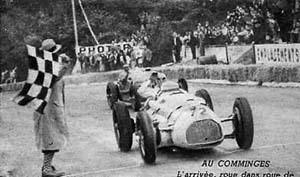 De Graffenried, Ascari and de Cortanze slowed down considerably. Louis Chiron, the craftiest of all drivers, took once more gifted a victory, heading home a Talbot 1-2-3 from Giraud-Cabantous and Chaboud (the picture on the right shows Chiron crossing the line ahead of YGC). Chiron had won the Grand Prix despite being only the sixth fastest in the race: Serafini, Villoresi, “Levegh”, Ascari and de Graffenried had made better times to no avail. Roger Loyer finished fourth overall on the same lap of the winner and winning the voiturette class. This often-underrated driver was the author of an extraordinary performance. He also pipped the powerful Maserati of de Graffenried by one-tenth of a second. Trintignant was sixth in Brault’s Delahaye showing a speed that that old car had never known in its racing life. He finished ahead of Ascari, who was very possibly having the most indifferent day of his entire racing career.
De Graffenried, Ascari and de Cortanze slowed down considerably. Louis Chiron, the craftiest of all drivers, took once more gifted a victory, heading home a Talbot 1-2-3 from Giraud-Cabantous and Chaboud (the picture on the right shows Chiron crossing the line ahead of YGC). Chiron had won the Grand Prix despite being only the sixth fastest in the race: Serafini, Villoresi, “Levegh”, Ascari and de Graffenried had made better times to no avail. Roger Loyer finished fourth overall on the same lap of the winner and winning the voiturette class. This often-underrated driver was the author of an extraordinary performance. He also pipped the powerful Maserati of de Graffenried by one-tenth of a second. Trintignant was sixth in Brault’s Delahaye showing a speed that that old car had never known in its racing life. He finished ahead of Ascari, who was very possibly having the most indifferent day of his entire racing career.
The Championship table showed: Chiron 25 points, Chaboud 23.5, Rosier 20, Louveau 19, Pozzi 18.5, Sommer & Giraud-Cabantous 16.5,, “Levegh” 14.5, E. Martin & Loyer 12. So, Chiron had taken the lead. Or had he?
The next round for the French Championship was the venerable Grand Prix de l’ACF held on September 21st. Chiron won that race too. Yet on September 22nd L’Equipe’s headline read:
Eugène Chaboud Champion de France
What had happened? The ACF had finally decided that Chiron did not qualify for the championship because of his Monégasque licence. It was a formally impeccable decision, yet it did not take into account Louis’ immense popularity. Chiron was also a French citizen and raced a French car for a French team. It was a highly unpopular decision also with the insiders. Journalist and former driver Roger Labric wrote: ”…regrettable… la non-qualification de Chiron … sous pretexte que sa licence lui fût delivrée en territoire monégasque” ('the fact that Chiron did not qualify on the pretext that his licence had been delivered to him in Monégasque territory was unwelcome'). An admirable twist of the truth in Labric’s words has to be noticed: “a licence delivered in Monégasque territory”, as if it were coming from France.
In any case we had: Chaboud 28.5, Louveau 25, Rosier 24, Pozzi 21.5, Giraud-Cabantous 17.5, Sommer 16.5,, “Levegh” 15.5, E. Martin & Loyer 12.
So, Chaboud was Champion de France for 1947, since the Coupe du Salon would not take place. Or was he?
Before going on to reveal the last twist in the story of the 1947 French Championship, we have to report on the autumn meeting at Monthléry. The re-opening of the Parisian track had revived this year the tradition of the spring and autumn multi-club meetings. The autumn meeting was organised by ACIF (the Paris and suburbs Autoclub), AGACI and CTA (the technical centre which had just been embarrassed by the behaviour of its product, the Arsenal GP car, at the GP de l’ACF. Three races were taking place, one for sports cars, a second for voiturettes and the third for “big” racing cars. Innumerable class winners were foreseen, in order to give awards to most drivers. It was Salon de l’Auto time, so the “big cars” race was named after an International Congress of Automotive Engineers that was taking place during it.
The race was nowhere near as lively as the spring event. Eugène Martin, who had just won the voiturette race, re-started, winning easily from Brault’s Delahaye, which lost one lap in a 45’ race, and Vedor’s strange Talbot. Martin was slightly slower than Varet who had won the race in the spring meeting over the same distance, 128.598 vs. 130,578 kph. Martin’s fastest lap was also slower than Mouche’s in the spring: 134.475 vs. 136.926 kph, but it had been a well-deserved good day for the excellent Martin.
The traditional Coupe du Salon should have been the last round of the Championship, but it had been cancelled. Yet, the following headline appeared above a short article in L’Equipe of October 16th:
Maybe the Coupe du Salon will be held in November
The news was not confirmed, so on October 24th there was a retraction:
The Coupe du Salon will not take place
Then, in larger print, on November 3rd:
The Coupe du Salon on 300 kms
The article said also that the race was going to be held on November 16th and that a strong Italian participation was foreseen. Most interestingly, perhaps, is that the locution F15 was used in the article to describe the Formula.
After all, Chaboud had not won the Championship yet and Chiron was not supposed to win it, so Chaboud’s strongest adversaries were Louveau and Rosier. Chaboud said that he had felt relieved after the Grand Prix de l’ACF, but now he felt under an even greater pressure. “I felt annoyed and the mechanics were the victims of the situation. To drive in those conditions of mind was not ideal, but I could do nothing else than race.”
In the end the Italians did not show. The new management at ASAI, the Italian drivers association, which now had a new secretary, Mugnai who had replaced Maggi, claimed that no offer had been received and said they were not coming. On November 13th the organizers released a statement to the effect that a telegram, which announced their coming, had just arrived. Mugnai immediately replied that no telegram had been sent. An underground polemic between Lurani and Filippini on one side and Canestrini, a backer of the new management, can be read between the lines of their respective articles on the matter. In any case, the consequence was that de Graffenried, Ascari, Villoresi, Pagani and Ruggeri did not show up. Only a two-stage Scuderia Milan car was sent for Sommer to back Louveau’s 4CL. Louveau had become a very serious contender for the Championship.
Another non-arrival was British quality car dealer John S. Gordon, later the builder of the Peerless and Gordon-Keeble cars, who had filed the strangest entry for a V8 Lancia Astura, but did not show up. Scuderia Ambrosiana president and driver Eugenio Minetti, who was also the proprietor of a big Lancia dealership in Milan, had this car made for the 1940 Mille Miglia. He was helped by Jano and by the Lancia factory in the preparation. It used modified cylinder heads with hemispherical combustion chambers on the Aprilia system and sported a neat sports car body by the Colli brothers. Gigi Villoresi was supposed to drive it with #75 in the race, but did not start for unknown reason. Cortese raced it in 1946 with two victories at Luino and Modena.
Ecurie France had returned the Talbot T26 sports to Lord Selsdon. The faster Talbot-Lago MD 90131 purchased from Chinetti had replaced it. Giraud-Cabantous drove it teaming up with Chiron’s usual MC. Rosier in the Talbot Spéciale 90111, Pozzi and Meyrat in Delahayes and Constantin in Louveau’s Delage completed the small field of Grand Prix cars, since Emile Cornet’s Delage practiced but did not start. Also it is not clear if Vedor, who had practiced too, was an actual starter in his usual coursified Talbot.
An official voiturette classification was also foreseen. The Cisitalias of Boyer, Loyer and “Robert” were opposed by Bonnet’s DB-Citroën and Jannin’s Fiat or Cisitalia Testa d’Oro. The small sports car had just been raced by its builder Giorgio Giusti in the sports car race at the autumn meeting, winning its class by a large margin.
A rather gloomy late November Sunday afternoon saw fourteen (or fifteen) cars at the start of a race which was going to be a dramatic one, a true to form Championship decider. Chiron started in front from first row followed by Giraud-Cabantous and Chaboud. Sommer’s engine stalled and it took a lot of time to get the car started. He roared off in pursuit, but too much time had been lost. By lap five he was fourth behind the three Talbots and by lap ten he had overtaken Chaboud. In the process he had set fastest lap in 2’29”4, not much faster than Chiron’s 2’31”2 and Cabantous’ 2’32”5 and not enough to catch them. Although Sommer’s pursuit was impressive it was in vain: his engine expired spectacularly by lap 18th, so he could not help teammate Louveau in the Championship race. Meanwhile Chaboud, who was cruising in front of Louveau, suffered a very unusual incident. A strap holding his bonnet came loose and the moving bonnet severed three of the plug cables. A very discouraged Chaboud had to stop at the pits. Repairs took 10 minutes and it was only at a mechanic’s very harsh insistence that Chaboud restarted. He was in eigth position when he furiously returned to the race. He had no other choice than to push his hardest. His best lap time was 2’37’, the fourth best of all competitors. At half distance Chaboud, beautifully directed and constantly encouraged by his pit signals, was already fourth. He had overtaken Rosier and taken advantage of the retirements of Sommer and Chiron on the same lap, the latter with a broken transmission, and of the refuelling stop of Louveau. By lap 30 he had passed Constantin and by lap 35 Pozzi. His pursuit had been steady and as fast as possible. Indeed, all the action took place three laps behind the leader, Yves Giraud-Cabantous (seen on the right), who won deservingly when dusk had already darkened the track, thus crowning a very good season. Louveau finished on the same lap as Chaboud, but he could catch neither Constantin, who was driving Louveau’s Delage, nor Pozzi who were interposed between him and Chaboud.
By lap 30 he had passed Constantin and by lap 35 Pozzi. His pursuit had been steady and as fast as possible. Indeed, all the action took place three laps behind the leader, Yves Giraud-Cabantous (seen on the right), who won deservingly when dusk had already darkened the track, thus crowning a very good season. Louveau finished on the same lap as Chaboud, but he could catch neither Constantin, who was driving Louveau’s Delage, nor Pozzi who were interposed between him and Chaboud.
Chaboud was the French Champion, this time for good. In the post race interview he thanked Pozzi, who by loaning him the Talbot had made possible the victory, giving up his own chances. Three articles were dedicated to Chaboud in a single issue of L’Equipe, on November 19th. They were peculiarly devoid of information but high in praise. Yet, even the casual reader could detect in them a shade of disappointment: of the confirmed French aces, Sommer had had a dismal season finishing only twice, in Le Sorcier’s cars, in Championship races, whereas Wimille had found his glory abroad driving a foreign car, not even starting in the top national event, the GP de l’ACF.
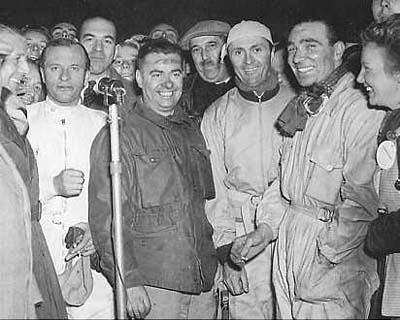
Chaboud, Giraud-Cabantous, Chiron, Louveau after the race.
Roger Labric, in the article already mentioned before, writes: ”... it would have been unwelcome too if Chaboud had not won the Championship…” The logical consequence of Labric’s words is clearly that two Champions would have been necessary, one for fairness and one for glory. Louis Chiron, whom the French public had always regarded as theirs, would have been perfectly appropriate for the latter.
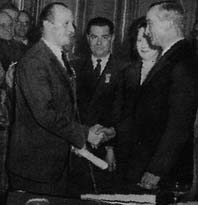
Eugène Chaboud receives the coveted prize.
Ecurie France had won four of the eleven Championship races; five were won by Maseratis of three different Italian teams, one each by Rosier and Martin. Charles Faroux wrote: ”... without Ecurie France, the French sport would have scored no success during the season…” This is true if we restrict our attention to the International Formula races and forget about Rosier, but two victories by Giraud-Cabantous in international sports car races and Martin’s and Gordini’s combined domination of the voiturette season are of no less significance.
1947 Championnat de France (highest scorers)
| Pau | Mars. | Nîmes | Remp. | Reims | Albi | Nice | Stras. | Comm. | ACF | Salon | Total | |
| Chaboud | 0.5 | 10 | 1 | - | 4 | 1 | 1 | 1 | 5 | 5 | 6 | 34.5 |
| Louveau | 5 | 5 | 1 | - | 1 | 1 | 1 | 4 | 1 | 6 | 3 | 28 |
| Giraud-C. | 0.5 | 1 | 1 | - | 1 | - | 1 | 6 | 6 | 0.5 | 10 | 27 |
| Pozzi | 0.5 | 1 | 3 | 1 | 1 | 5 | 3 | 3 | 1 | 3 | 5 | 26.5 |
| Rosier | - | 1 | 1 | - | 1 | 10 | 1 | 5 | 1 | 4 | 1 | 25 |
| Sommer | 2 | 1 | 1 | 2.5 | 1 | 6 | 2 | - | - | 1 | 2 | 18.5 |
| “Levegh” | 6 | 4 | 1 | - | - | 1 | 1 | 0.5 | 1 | 1 | - | 15.5 |
Click here to continue to part 3: The Statistics
Notes
1. 600,000 kms were run for testing on the Autodrome during 1951. This figure increased to 1,704,000 kms.during the first semester of 1961.
2. Three of Walter Watney’s Delages 3L were driven by Gérard, Blanchi and Varet, two Delahayes by Achard and Grignard, a Talbot T150C c/n 82931/90201, by Neuilly garagiste Francois Cuillier. Bonnet drove his DB-Citroen, de Montrémy the new SIMCA-Monopole. The following drivers were also recorded as present: Ondet, Roumani, Pouzin, Lescudet, Jeff, Harcourt, Mouche, Le Jamtel, Dourians, Lascaut, Hahn, Deutsch, Landrin, Florentin, Chauvin, Duval…
3. German historian Hans-Peter Rosellen tells the story in a slightly different way. The Veritas team was escorted by French military to Strasbourg, but only a few minutes before the start they had to learn that they were not allowed in. The race director, who informed Loof, was so keen to leave the place as fast as possible, that he ran into a passing motorcycle and lost a leg!
4. Faroux’s guess was that no Maserati would finish the race in the top positions. He was right.
5. The date of first use of the term F1 has been the occasion for heated discussions among enthusiasts. The above instance is the earliest one found while researching for this book.
Quotes
- Faroux on Pau (EQU) 8/4/1947
- On Pagani, Levegh, Achard at Pau (AcA) May 1947
- On Perpignan (EQU) 28/4/1947
- On Marseille (EQU) 21/5/1947
- Connell at Marseille (CON)
- On Platé and “Hellé-Nice” at Marseille {AcA) June 1947
- Further comments on Marseille (EQU) 23/5/1947
- On the track at Nîmes (EQU) 26/5/1947
- Chiron at Perpignan (EQU) 29/4/1947
- On the ERAs E-type at Reims (CSH) p. 125
- On Sommer’s Maserati at Reims (JG2) p.23
- On Gerard-Harrison at Reims (JG2) p.24
- Connell at Albi (CON)
- On Sommer at Albi (JG2) p.27
- On Rosier (EQU) 15/7/1947
- On Nice (EQU) 18/7/1947
- On Wimille at Nice (JG2) p. 29
- On Sommer at Nice (JG2) p. 29
- On Strasbourg (EQU) 2/8/1947
- Labric on Chiron (AA1)
- Chaboud and the Championship (EQU) 17/11/1947
- Labric on Chaboud (AA1)
- Faroux on Ecurie France (EQU) 25/9/1947.
Sources
- AA, Author's Archives
- AB*, AB**, Pierre ABEILLON, Talbot-Lago de course, Ed. du 22 Janvier, 2 volumes, Vandoeuvre CH, 1992
- AB1, Pierre ABEILLON, Delahaye 135S, in ??
- AB2, Pierre ABEILLON, Talbot Monoplace I, in Automobile Historique,n°9, July-August 2001
- AB3, Pierre ABEILLON, Talbot Monoplace II, in Automobile Historique,n°10, September-October 2001
- AB4, Pierre ABEILLON, Ciro Basadonna. Un amateur chez les Professionnels. in Retroviseur, n° 123, November 1998
- AB5, Pierre ABEILLON, Les dernières Delage de course, La Galérie des Damiers 4, Les Damiers, Lille, 1998 pp.4-15
- AC1, Cyril POSTHUMUS, By George, in Classics and Sportscar, October 1987
- AC2, Philip TURNER, Abecassis, in The Motor, Febr. 23, 1980
- AC3, Doug NYE, Obituary: George Abecassis, in Thoroughbred and Classic cars, March 1992
- AcA, L'ACTION AUTOMOBILE, yrs 1945, 1946, 1947, 1948
- ACF, David HODGES, The French Grand Prix, Temple Press Books, London, 1967
- AFF, Adam FERRINGTON, Collection
- AIT, AUTO ITALIANA, yrs 1946, 1947, 1948, 1949
- ALB, Bernard PELISSIER, Albi et ses Grands Prix, Narbonne 1990.
- ALT, Graham GAULD, The early Alta racers, in Historic Motor Racing, vol I #3, 2001
- AMI, Gilles FOURNIER, Amilcar, Ed. Rétroviseur, 1994
- ANS. Anthony PRITCHARD, Brewery Boy (Bob Ansell), in The Automobile, Aug. 2002
- APP, John APPLETON, The Appleton Special, in The Motor, Jan. 20th, 1943
- ARA, Alberto SALOTTO, Los Alfa Romeos in Argentina, in Automundo, 27/06/1967
- ASC, Cesare DE AGOSTINI, Antonio e Alberto Ascari, Ed. de L'Automobile, Roma 1968
- AS2, Karl LUDWIGSEN, Alberto Ascari, Ferrari’s first double champion, Haynes Publishing Co, Sparkford, 2000
- AS3, Kevin DESMOND, The man with two shadows, Proteus, London, 1981
- AUT, The AUTOCAR, yrs 1945, 1946, 1947, 1948, 1949
- BAR, Luigi AMATI, 50 anni di automobilismo sportivo in Puglia, a cura di Gianni Resta, Grafischena, Fasano, n.d.
- BEA, D.M. Kenneth Bear, Obituary, in The Autocar 6/5/1949
- BGP, Doug NYE, The British Grand Prix, B.T. Batsford, London, 1977
- BIA, André BIAUMET, Les Grands Prix des Frontières, vol 1, ed. Biaumet, Morlanwelz 1986
- BIR, Princess Cheryl BIRABONGSE, The Prince & I, Veloce Publishing, Godmanstone 1992, rev. Ed. 1998
- BLI, Anthony BLIGHT, The French Sports Car Revolution, Foulis, Haynes Publ. Co. Sparkford, 1996
- BLB, Serge BELLU, Blue Blood, Engl. Ed. , Frederick Warne, 1979
- BOL, Cyril POSTHUMUS, John Vary Bolster, Classic & Sports cars
- BRC, B.A.R.C. Yearbook 1953, British Automobile Racing Club, London, 1953
- BRE, Brochure for the Classic Car event held in Turin for the 40th aniversary of the Turin GP and the Coppa Brezzi, Turin, 1986
- BRT, Pierre ABEILLON, René Berté et ses sept monoplaces, Rétroviseur # 82, Juin 1995
- BRU, Gunther MOLTER, (Egon BRUTSCH)
- CAN, Giovanni CANESTRINI, Uomini e Motori, Ed. Nuova Massimo, Monza 1957
- CA2, Giovanni CANESTRINI, Una vita con le corse, ed. Calderini, Bologna 1962
- CAR, Emanuele Alberto CARLI, Settant'anni di corse automobilistiche in Italia, Ed. de L'Automobile, Roma 1967
- CCH, Adriano CIMAROSTI, GP Suisse, Hallwag, Bern, 1992
- CDB, Richard CRUMP, Rob de la RIVE BOX, Maserati etc., 2nd ed., Haynes Publishing Co., Sparkford, 1983
- CHA, Jean BERNARDET, André Chardonnet, un personnage unique, I, Rétroviseur # 78, Février 1995
- CHI, David BURGESS WISE, “The old fox of Monaco”, in the World of Automobiles, Orbis Co. London 1974, Am. Ed. Columbia House 1975
- CHO, Pierre FOUQUET-HATEVILAIN, En Quête d’aventures, (Pierre Chôtard) in La Vie de l’Auto # 873, 7/01/1999
- CHU, Prince CHULA CHAKRABONSE of Siam, Blue and Yellow, Foulis, London, 1947
- CIS, Nino BALESTRA, Cesare DE AGOSTINI, Cisitalia, Catalogue Raisonné 1945/1965, Automobilia, Milano 1991
- COH, Edmond COHIN, L'Historique de la Course Automobile, 2nd ed, Ed. Larivière, Paris, 1979
- COL, Gioachino COLOMBO, Origins of the Ferrari legend, Haynes Publishing Co., Sparkford, 1987
- CON, Ian CONNELL, Letter to the author, November 10th 2001
- COO, Doug NYE, Cooper Cars, Osprey Publ. Ltd., London, 3rd ed., 1992
- COU, William COURT, Power and Glory, 1st ed., MacDonald, London, 1966
- CRC, Rudolf CARACCIOLA, A racing car driver world, Farrar, Straus and Cudahy Inc., New York, 1961
- CRO, Tony CROOK, The Bristol Connection, Old Motor, Aug. 1981
- CSH, Norman SMITH, Case History, Autosport, London, 1958
- CUF, Robert CUTTER – Bob FENDELL, The Encyclopedia of Auto Racing Greats, Prentice Hall, Englewood Cliffs NJ, 1973
- DB, François JOLLY, DB, la renaissance du sport automobile en France, Ed. du Palmier, Nîmes 2002
- DEH, Pierre FOUQUET-HATEVILAIN, L’aventure bleue des SIMCA-Deho, in La Vie de l’Auto # 827, 15/01/1998
- DEL, J. DORIZON, F. PRIGUEY, J.-P. DAULIAC, Delahaye, le Grand Livre, E/P/A, Paris, 1995
- DLH, François JOLLY, Delahaye, sport et Prestige, new ed., Librairie du Palmier, Nîmes, 2003
- DGF, Mike TWITE, “The epitome of a wealthy amateur” (E. de Graffenried), in the World of Automobiles, Orbis Co. London 1974, Am. Ed. Columbia House 1975, p. 816
- DG2, Pierre FOUQUET-HATEVILAIN, Le Baron au trident, (E. de Graffenried) in La Vie de l’Auto # 726, 30/11/1995
- DRE, Louis DREYFUS, My two lives,
- DSX, Jean-Paul DELSAUX, 100 ans de Sport Automobile Belge, ed. J.P. Delsaux, 1996
- DUV, Pierre ABEILLON, Pierre Duval, ingénieur, constructeur et pilote, Rétroviseur # 92, Avril 1996
- EQU, L'EQUIPE, yrs 1946, 1947, 1948, 1949
- ETZ, Hans ETZRODT, GP Winners, 1895/1949.
- EVA, Wilson McCOMB, The end of the Evanses, Classic & Sports car, Sept 1988
- FAN, Karl LUDWIGSEN, Juan Manuel Fangio, Motor Racing’s Grand Master, Haynes Publishing Co, Sparkford, 1999
- FAR, Pierre ABEILLON, Nino Farina, un veritable guerrier, in La revue de l’Automobile Historique, # 5, 2000
- FER, Enzo BIAGI, “Ferrari”, II ed. de Agostini, Novara, 1985
- FRA, Alf FRANCIS & Peter LEWIS, Racing Mechanic, G.T. Foulis and Co., London, 1957
- GAR, Giancarlo CAVALLINI, Circuito del Garda, Fondazione Negri, Brescia 2001
- GDW, Mike LAWRENCE, Simon TAYLOR, Doug NYE, The Glory of Goodwood, Virgin Books, London, 1999
- GE1, Philip TURNER, Obituary Bob Gerard, in Old Motor, November 1981,
- GE2, Gordon HORNER, Bob Gerard, ??,
- GEO, G.N. GEORGANO, editor, The Encyclopedia of Motor Sport, The Viking Press, New York, 1971
- GF2, Gregor GRANT, Formula 2, Foulis, London, 1953
- GF3, Gregor GRANT, Formula 3, Foulis, London
- GIO, Enzo FERRARI, Le mie Gioie Terribili, Cappelli, Bologna, 1962
- GOZ, Franco GOZZI, Alla destra del Drake, Giorgio Nada Ed., Milano 2003
- GRA, EL GRAFICO, Buenos Aires, yrs 1946/1947/1948/1949
- GRS, Gregor GRANT, British Sports Cars Foulis, London, 1947
- GSP, LA GAZZETTA dello SPORT yrs 1945/1946/1947/1948/1949
- HAM, Obituary, David Hampshire, Autoclassic, Sept 12 1990
- HAR, Andrew WHYTE, “Cuth”, in Classic & Sports Cars, Oct. 1985,
- HAW, Mike HAWTHORN, “Challenge me the race”, It. Ed., Calderini, Bologna, 1960
- HUE, Christian HUET, Gordini, un Sorcier, une Equipe, ed. C. Huet, Paris, 1983
- I46, Indianapolis 500 Chronicle
- IAU, INTERAUTO, yrs. 1946/47/48/49
- ITA, Paolo MONTAGNA, Ed., The Legendary Italian Grand Prix, AC-Promotion, Milan, 1989
- JEF, Sacré “Jeff”, La Vie de l’Auto 6/9/1990
- JEG, John EASON GIBSON, Motor Racing 1946, Motor Racing Publications Ltd., Abingdon, 1948
- JG2, John EASON GIBSON, Motor Racing 1947, Motor Racing Publications Ltd., Abingdon, 1949
- JK1, Denis JENKINSON, Directory of Historic Racing Cars, Aston Publ. Ltd., Bourne End 1987
- JK2, Denis JENKINSON, Motor Sport Racing Car Review 1949, Grenville Publ. Co., London, 1948
- LGJ, Bill BODDY, Businesslike Performer (Leslie Johnson), in Motorsport, June 2002
- LO1,2,3, Maurice LOUCHE, Un siècle de grands pilotes français, vol.s 1,2,3, ACF, Paris, 1995
- LOM, Maurice LOUCHE, Les Grands Prix de Marseille et Provence, ed. Maurice Louche, 1998
- LOY, Pierre FOUQUET-HATEVILAIN, La Course Auto-moto en parallèle (R. Loyer), La vie de l’Auto 9/1/1997
- LU1, Giovanni LURANI CERNUSCHI, La storia delle Mille Miglia, de Agostini, Novara, 1979
- LU2, Giovanni LURANI CERNUSCHI , Corse nel Mondo, II ed. Edisport, Milano 1955
- LU3, Giovanni LURANI CERNUSCHI, Storia delle Macchine da Corsa, Ed. de L'Automobile, Roma 1970
- LUN, The Lund Special, Thoroughbred & classic car 1975
- LVS, Karl E. LUDVIGSEN, Grand Prix Cars of the Forties, in Automobile Quarterly, vol 11, #3, 1973
- M8C, Larry CRANE, Maserati’s immortal Supercar, in Historic Motor Racing, vol I no°5, 2001
- MNK, George MONKHOUSE, Grand Prix Racing, Foulis, London, 1950
- MNN, Pierre ABEILLON, Les Monnier Speciales, Rétroviseur # 78, Février 1995
- MNZ, Jean-Pierre SURMONNE, Robert Manzon, rencontre avec un chevalier de Marseillle, in Automobile Historique, April 2003
- MON, Pierre ABEILLON, Monopole, Un sous-traitant dans la course, in Rétroviseur # 106, Juin 1997
- MOS, Stirling MOSS, “Book of Motor Sport”, Italian ed, Calderini Bologna, 1958
- MOT, THE MOTOR, yrs 1945/1946/1947/1948
- MR2, 500cc Motor Racing Yearbook-1952, Pearl Cooper, London n.d.
- MR3, Formula III - Motor Racing Yearbook-1953, Pearl Cooper, London n.d.
- MR5, Motor Racing Directory 1955/1956, Pearl Cooper, London n.d.
- MSP, MOTORSPORT, yrs 1946/1947/1948/1949
- NAC, La NACION, Buenos Aires, yr 1947
- NAV, Christian NAVIAUX, Les Grand Prix de Formule 1 hors du Championnat du Monde, Editions du Palmier, 2002
- OZM, Luigi ORSINI – Mario ZAGARI, Maserati, La libreria dell’automobile, 1980
- PAR, Graham GAULD, Reg Parnell, Patrick Stephens, Ltd, Sparkford nr. Yeovil, 1996
- PAU, Pierre DARMENDRAIL, Le Grand Prix de Pau (1899/1960), La Librarie du Collectionneur, Paris, 1992
- PNF, Pininfarina. Cinquant’anni, Automobilia, Milano, 1980
- PO1, Cyril POSTHUMUS, A Maserati Masterpiece. The story of Tipo 8C-3000 - No 3002 in Classic & Sportscar, October 1982.
- POM, Lawrence POMEROY, The Grand Prix car, vol II, Ed. on CD-rom, Engineering Information Services
- PRG, Alfredo PARGA, Mas de 100 años de automovilismo argentino. Historia de una pasion, Editorial Atlantida-Isaura, Buenos Aires, 1992
- PRI, Anthony PRITCHARD, Maserati: a history, David&Charles, Newton Abbot, 1976
- PRO, Prontuario dell'Automobilismo Sportivo (Giovanni CANESTRINI, Luigi GRASSI, Andrea FUMAGALLI eds.) Unione Italiana Giornalisti dell'Automobile, Roma 1956
- PRP, Frédéric MARTY, GP du Roussillon 1946, in La Vie Automobile, #1078, 1/5/2003
- RAC, François JOLLY, L'épopée française des "Racers 500", 1949-1959, Editions du Palmier, Nîmes 1999.
- RAF, Antoine RAFFAELLI, Archives d’une passion, Ed. Maeght, Paris 1997
- REI, Dominique DAMERON-DERAUW, Cyrille MELIN, Jean-Pierre MELIN, Reims, Vitesse Champagne et Passion, L'Atelier Graphique, Reims, 1998
- RMA, Pierre ABEILLON, Raoul-Martin. Trois Simca pour la course, Rétroviseur 84, Août 1995.
- ROL, Phil LLEWELLIN, Tony Rolt. Un modeste parmi les grands. (Jean-Claude Lequi ed.) in Rétroviseur 139, March 2000.
- SAF, Frank HOAL, Post-war Racing in South Africa, in Classic Car Africa, III 1995
- SCH, John BOLSTER, ‘Aree, in Old Motor, October 1982
- SHE, Paul SHELDON with Duncan Rabagliati, Yves de la Gorce, Jean-Maurice Gigleux, A Record of Grand Prix and Voiturette racing, vol 4, 1937/1949, St. Leonard Press, Bradford, 1993
- SHT, Alan HENRY, Brian Shawe-Taylor, Obituary,
- SM1, “Un grand champion de course automobile, Raymond Sommer, 1906-1950” Fondation François and Pierre Sommer, 2001
- SM2, David BURGESS WISE,, “Raymond the Lionheart”, in the World of Automobiles, Orbis Co. London 1974, Am. Ed. Columbia House 1975, p. 2089
- SMS, Claude CHEVALIER, Salmson, Histoire d’un nom, ETAI, Paris 1997
- SNE, Leif SNELLMAN, The Golden Era
- SPI, Alain SPITZ, Des Talbot-Darracq aux Talbot-Lago, E/P/A, Paris, 1983
- SPL, John V. BOLSTER, Specials, II rev. ed., Foulis, London, 1950
- SPO, Andrea CURAMI - Piero VERGNANO, La "sport" e i suoi artigiani, 1937-1965, Giorgio Nada Editore, Milano 2001
- STA, Dante CANDINI, Nunzia MANICARDI, Stanguellini il mago dei motori, Ed. Il Fiorino Modena 1999
- TAB, Maurizio TABUCCHI, Nel segno del Tridente, Giorgio Nada Ed., Milano 2003
- TAR, Piero TARUFFI, Bandiera a Scacchi, Artioli, Modena-Milano, n.d.: English Transl., Works Driver, Temple Press, London, 1964
- TEN, Alessandro COLOMBO, Tenni nel Cinquantenario della Scomparsa, Museo Nazionale di Scienza e tecnica, Milano, 1998
- TRA, Erwin TRAGATSCH, Das grosse Rennfahrerbuch, Hallwag, Bern
- TRO, Pierre FOUQUET-HATEVILAIN, La saga d’un prince russe, (Igor Troubeztkoy) La vie de l’Auto, #854, 20/8/1998
- UEC, “UECHTEL” (Markus Neugebauer), Phoenix from the flames, 8w@forix.com
- VAL, Pablo GIMENO VALLEDOR, Los grandes premios internacionales de la Penya Rhin, Fundaciò Can Costa, Barcelona, 1997
- VAR, Giorgio TERUZZI, Una Curva Cieca (Achille Varzi), Giorgio Nada Ed., Milano, 1991
- VEN, David VENABLES, First among Champions, Haynes Publ. Co., Sparkford, 2000
- VE2, David VENABLES, The racing Fifteen-hundreds, Transport Bookman Publ., 1984
- VE3, David VENABLES, Bugatti, a racing history, Haynes Publ. Co., Sparkford, 2002
- WAL, Michael COOPER-EVANS, Private Entrant – Racing with Rob Walker, Cassell & Co. London 1966
- WIM, Mike KETTLEWELL, “Taming of the wild man” (J.-P. Wimille), in the World of Automobiles, Orbis Co. London 1974, Am. Ed. Columbia House 1975, p. 2569
- WML, Jean-Michel PARIS & William D. MEARNS, Jean-Pierre Wimille, à bientôt la revenche, Drivers, Toulouse, 2002
- YB1, Laurence POMEROY & R.L. de Burgh WALKERLEY, The Motor Yearbook 1949, Temple Press London 1949
- YB2, Laurence POMEROY & R.L. de Burgh WALKERLEY, The Motor Yearbook 1950, Temple Press London 1950
- ZOR, Jerry BURTON, Zora Arkus-Duntov, the legend behind Corvette, Autoweek, June 3, 2002
